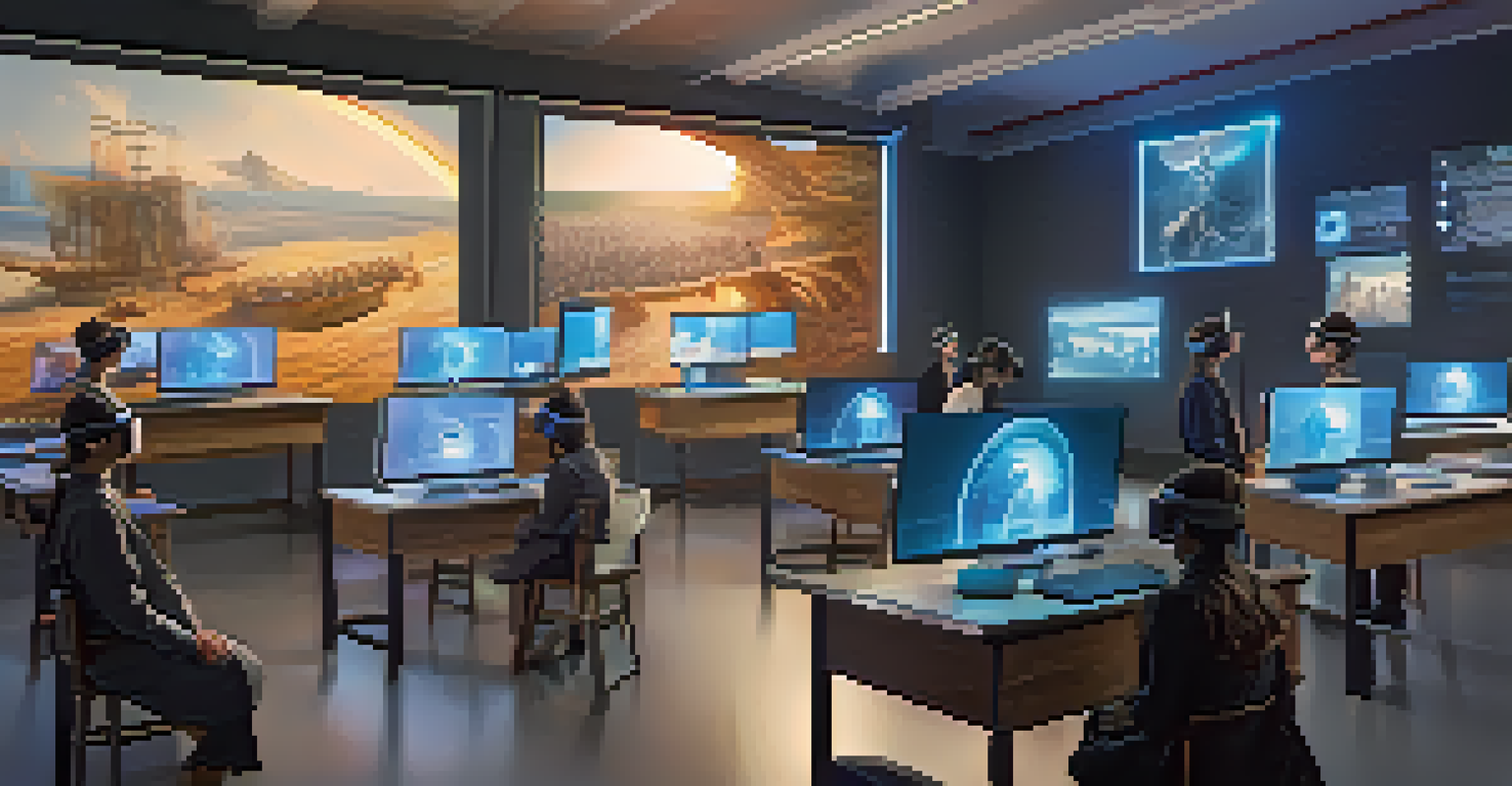Exploring Emotional Engagement in Transmedia Learning

Understanding Transmedia Learning: A Brief Overview
Transmedia learning involves the use of multiple media platforms to create a cohesive educational experience. Imagine a story that unfolds across books, games, films, and websites, each contributing unique elements to the narrative. This approach allows learners to engage with content in diverse ways, catering to different learning styles and preferences. By weaving together various formats, transmedia learning can make lessons more immersive and memorable.
The mind is not a vessel to be filled, but a fire to be kindled.
One of the core ideas behind transmedia learning is the concept of narrative transportation, where learners become emotionally invested in the story. When a learner connects with a character or situation, they are more likely to absorb and retain information. This emotional connection can turn a simple lesson into a powerful learning journey, enhancing motivation and engagement.
Incorporating emotional engagement into transmedia learning not only makes the experience enjoyable but also promotes deeper understanding. As learners navigate through different media, they can explore various perspectives and contexts, enriching their overall comprehension. This multifaceted approach encourages curiosity and fosters a love for learning.
The Role of Emotional Engagement in Learning
Emotional engagement is the spark that ignites a learner's interest and motivation. When emotions are involved, learners are more likely to remember what they have experienced. For instance, a student who feels empathy for a character in a historical narrative is more inclined to explore that period further, connecting emotionally with the content.

Research has shown that emotional responses can enhance cognitive processes, such as attention and memory retention. When learners are emotionally engaged, they often experience a sense of belonging, which can create a supportive learning environment. This sense of community can be especially powerful in a transmedia context, where learners can share their experiences and insights across different platforms.
Transmedia Learning Engages Emotions
By utilizing multiple media platforms, transmedia learning creates immersive experiences that foster emotional connections and enhance retention.
Moreover, emotional engagement allows for personalized learning experiences. By tapping into learners' emotions, educators can tailor content that resonates with individual interests and values. This can make the learning experience not just informative, but transformative.
Transmedia Storytelling: Engaging the Emotions
Transmedia storytelling is a key component of emotional engagement in learning. It creates a rich tapestry of narratives that unfold across different media, allowing learners to explore stories from multiple angles. For example, a story about climate change might be told through a documentary, a video game, and an interactive website, each offering unique insights and emotional touchpoints.
Learning is not the product of teaching. Learning is the product of the activity of learners.
By engaging with characters and situations across various platforms, learners can develop a deeper emotional connection to the subject matter. This connection can lead to a greater sense of responsibility and advocacy, especially in topics that require social awareness and action. The emotional journey becomes a catalyst for change, inspiring learners to take initiative.
Additionally, transmedia storytelling often includes interactive elements that promote active participation. When learners can influence the narrative or make choices within the story, their emotional investment increases. This participatory aspect can be incredibly fulfilling, making the learning experience not only educational but also enjoyable.
Creating Emotional Connections Through Characters
Characters are often the heart of any story, and in transmedia learning, they play a crucial role in fostering emotional connections. Learners may find themselves relating to characters who face challenges or triumphs similar to their own experiences. This relatability can deepen their engagement and motivate them to explore the content further.
For example, a character in a transmedia narrative who struggles with self-doubt can resonate with students dealing with similar issues. By seeing how that character overcomes obstacles, learners may feel inspired to tackle their own challenges. This emotional bond creates a safe space for reflection and personal growth.
Characters Drive Emotional Investment
Relatable characters in transmedia narratives help learners forge emotional bonds, motivating them to engage more deeply with the content.
Moreover, diverse characters can represent a variety of perspectives, allowing learners to empathize with experiences different from their own. This exposure can broaden their understanding of the world, fostering inclusivity and social awareness. In this way, characters serve as conduits for emotional engagement, making lessons more impactful.
Interactive Elements: Enhancing Emotional Engagement
Interactive elements in transmedia learning can significantly boost emotional engagement. When learners can actively participate in the narrative—whether through quizzes, games, or simulations—they feel a greater sense of ownership over their learning. This active involvement fosters a deeper emotional connection to the content.
For example, a history lesson presented through a role-playing game allows students to make decisions as historical figures, immersing them in that time period. The emotional stakes become higher as they navigate challenges and dilemmas, leading to a more memorable learning experience. This hands-on approach transforms passive learning into an adventure.
Additionally, interactive elements encourage collaboration among learners, creating opportunities for shared emotional experiences. Working together to solve problems or complete tasks can strengthen bonds and build a supportive community. This communal aspect of learning can further enhance emotional engagement, making the process even more enriching.
Challenges of Emotional Engagement in Transmedia Learning
While emotional engagement offers numerous benefits, it also presents challenges in transmedia learning. One significant challenge is ensuring that the content remains coherent across various platforms. If the narrative is disjointed or confusing, learners may struggle to connect emotionally with the material.
Another challenge is balancing emotional depth with educational goals. While it's essential to engage learners emotionally, it's equally important to ensure that the content is informative and aligned with learning objectives. Striking this balance can be tricky, as overly emotional content might detract from the educational purpose.
Interactivity Boosts Learning Engagement
Interactive elements in transmedia learning encourage active participation, leading to stronger emotional connections and collaborative experiences.
Additionally, not all learners may respond to emotional engagement in the same way. Some may prefer analytical approaches to learning, while others thrive on emotional connections. Understanding these diverse preferences is crucial for educators looking to implement transmedia learning effectively.
The Future of Emotional Engagement in Transmedia Learning
As technology continues to evolve, the potential for emotional engagement in transmedia learning is vast. Innovations such as virtual reality (VR) and augmented reality (AR) are paving the way for even more immersive experiences. Imagine learners stepping into a historical event or exploring a scientific concept in a fully interactive environment—this is the future of education.
Furthermore, the rise of personalized learning platforms allows for tailored emotional engagement strategies. Educators can use data analytics to understand learners' preferences and emotional responses, creating customized content that resonates deeply. This level of personalization can transform the learning experience, making it more relevant and impactful.

Ultimately, the future of emotional engagement in transmedia learning holds great promise. By harnessing technology and creativity, educators can create transformative learning experiences that not only educate but also inspire. As we continue to explore this exciting frontier, the potential for emotional connections in learning will only grow.